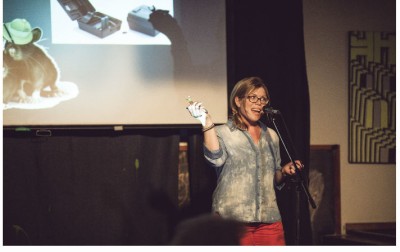Part 3: The Medium
3.5 Face-to-Face Communication
Learning Objectives
- To outline the benefits of face-to-face communication.
- To demonstrate different tools and techniques to facilitate public presentations and direct dialogue.
- To understand the additional considerations for facilitating face-to-face communication over videoconference.

Talking to people face-to-face is one of the best ways to get your message across and communicate with your intended audience. This is because face-to-face communication, or F2F for short, employs more types of messaging cues than other forms of communication. As discussed in the previous section on speaking to mainstream media, which simulates in-person communication, your message is complemented by a number of non-verbal cues including body language, voice quality, facial expressions and presence. Further, F2F communication can be enhanced by visual aids and reinforced through concise, memorable and emotion-inciting words. All of these different messaging cues can help make your message more engaging and persuasive.
In fact, there is biological basis for why F2F communication is such a potent medium to deliver your message. Neuroscience research has shown that when two people converse, their brain activity synchronize more than through any other medium of communication. This suggests that F2F communication enables richer and more effective communication compared with less direct modes.
You may choose to deliver your F2F communication as a presentation to a public audience or opt for conversations one-on-one or in a small and intimate group. The setting and audience size will depend on your goal and relationship with your audience. The section below presents some considerations for F2F messaging.

Comparing face-to-face communication delivery methods
Once you have determined F2F communication to be feasible and meaningful for your communication project, your need to decide your delivery method. Will you share your message to small groups through direct dialogue or give a presentation to a bigger audience? Further, the COVID-19 pandemic has taught us to move many traditionally in-person activities online. As such, you may want to consider employing video conference presentations, too. The following table outlines the benefits, drawbacks and other considerations around each of these three primary F2F communication delivery methods.
| Small Group Dialogue | In-Person Presentation | Video Conference | |
| Benefits |
|
|
|
| Drawbacks |
|
|
|
| When to Use |
|
|
|
Tips for effective face-to-face communication
Find (or be) the best spokesperson
As was the case with speaking to the mainstream media, your spokesperson should be credible, use language that your audience will understand and exhibit appropriate body language. However, with F2F communication, the audience can actually talk back. For this reason, it is important that your spokesperson also be capable, in terms of expertise and authority, to address any concerns that arise.
One strategy is to employ multiple spokespeople with complementary areas of expertise and/or organizational affiliations yet share a unified message. Agreement among experts, particularly those from different fields and organizations, will increase audience confidence. However, it does not work if the audience perceives the group of experts as ganging up on them or if the spokespeople start arguing with each other.
Finally, it is important to keep in mind that the audience’s perception of the spokesperson—their likeability, reputation and credibility—will play a huge role in determining the audience’s response and their willingness to accept the message.
Pair with written or online materials
Think about the classes you have sat through where your instructor flashed up a series of information-loaded slides covering all the points that you will need to pass your final exam. You either focus entirely on the speaker but risk forgetting things later on, or you spend so much time manically scribbling down notes that you don’t have the headspace to actually engage with the content. Instead, had the instructor provided you with a notes package containing all the contents of the slides, you could have more easily directed your full attention to the class, knowing that the facts and figures will be available at your fingertips later.
Similarly, it is important to provide the audience of your F2F engagement sessions with some form of written communication, either on paper or online. The handout should cover the most important information in your message and be available prior to the session. The audience can then refer to the material during the session if they are confused and add their own notes, which encourages active listening, engagement, learning, and retention. However, make sure that your presentation does not duplicate word for word the contents of your written material, which could risk having the opposite effect and leave your audience bored and disengaged.
Reinforce (but don’t replace) your message with visual aids
PowerPoints are the conventional visual aid to a presentation. However, reflect critically on whether your message will be elevated by having one or if you will end up relying on the slides as a crutch to read off of. Should you decide to use presentation slides, craft your speaking notes first and use your slides to present visuals or phrases to clarify or emphasizes key components of the message.
Here are a few principles to making simple, readable and non-redundant slides:
- Your slides should require explanation – that is what your presentation is supposed to do!
- Use high-quality images, preferably photographs.
- Keep text at a minimum. If you do use text, make it readable by using large font sizes (28-40 point for headlines and 18-28 for text), sans serif fonts and font colours that contrast well with the background.
- Use the slide sorter function to review your presentation as a whole to make sure it has a logical flow that your audience can easily follow.
For a helpful list of tips for creating effective presentation slides, see communications consultant Garr Reynold’s website post.
Have a follow up mechanism
Often, you will emerge from a F2F event with outstanding audience questions that you didn’t have time or the full information to answer, or new action items based on discussions during the event. If you don’t follow up on these items, or if you follow up but your audience does not know about it, then you will lose credibility. For a small group, it may work to follow up by email. For a larger group, you could use social media or a website to broadly publish your follow-up information.
Practice, practice, practice
Know your presentation inside and out plus anticipate and practice answering questions. This is particularly important if your audience could be hostile or if the stakes are high. You can do this by practicing in front of friends or colleagues to get feedback. Alternatively, try filming or recording your presentation to have a better sense of your speaking manner and pacing.
Further, it is important to ensure you have all the necessary equipment and aids ready so you’re not taking up people’s time or coming off as unprepared during set-up. Having back-ups of your speaking notes, presentations slides or other necessary aids can also be helpful.
Consider the setting
Is the location somewhere that people will feel comfortable? Locations that are on the audience’s ‘home turf’ or at least a neutral location may be preferable over asking people to come to you. If you are not familiar with the location, visit it in advance with an eye towards accessibility, seating, acoustics, and lighting. For example, theatre-style seating is often the norm, but it can be subconsciously adversarial by creating an us vs. them sort of arrangement. If it is a small enough group, opt instead for boardroom-style seating that puts everyone on an equal plane. Similarly, can people hear you from all parts of the room or will you need a microphone? Does the lighting allow people to see both you and your presentation?
Be as inclusive as possible
One of the main reasons that you would have chosen F2F communication over other media is that it allows audiences to interact with you. This means that you should do everything in your power to efficiently and effectively include audience interaction in your communication plan and that all members of your audience have an equal opportunity to interact, not just the loudest voices. For example, instead of having people stand up and ask questions at an event, which can feel daunting for many, use audience engagement sites like Slido, Menti or Poll Everywhere so audience members can connect to a presentation through their smartphones and submit questions anonymously.
Equity and accessibility are also important considerations to ensure your F2F messaging reaches as many people as fairly as possible. This often entails analyzing your expected audience demographic for preferred language, linguistic comprehension and ability. Do you need interpreters at your event, including sign language interpreters? Are you speaking in lay language that is comprehensible to audiences who don’t have any expertise in the subject matter or who may not have post-secondary education? Accommodating the needs of all your audience members will reinforce the credibility of your message and spokesperson and lower the chances that your message will be lost or misunderstood.

Takeaways
Key Takeaways
- Face-to-face (F2F) communication is one of the most engaging and persuasive media you can use thanks to its direct and responsive nature.
- F2F communication can be delivered in small groups or as a presentation, either in-person or online. The delivery method you use should depend on your goal, the complexity of your message and your relationship with the audience.
- Choose a credible spokesperson who can deliver the message using language that can be easily understood by the intended audience.
- Always consider accessibility, whether it be for in-person meetings (e.g. space accessibility, translation, etc.) or online (e.g. access to internet and the platform being used).
Media Attributions
- Byers Presentation © Lindsay Elliott is licensed under a CC BY (Attribution) license
- Laptop video call © Chris Montgomery is licensed under a CC0 (Creative Commons Zero) license

